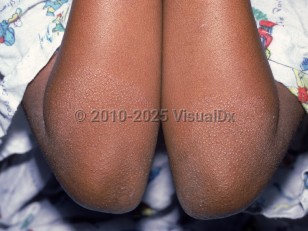Lichen spinulosus in Adult
Alerts and Notices
Important News & Links
Synopsis

Lichen spinulosus is a rare and benign cutaneous disorder characterized by sudden onset of localized circumscribed plaques composed of follicular hyperkeratotic papules. It most frequently occurs in children and adolescents; however, young adults can also be affected. There is a slight male preponderance. Individuals of any race can be affected. The etiology and pathogenesis are not known, although atopic, infectious, and genetic factors have been proposed as causes. Patients often have a history of atopy. An actinic variant has been described in which patients suddenly worsen in the summer or present following acute prolonged ultraviolet (UV) exposure, such as attending outdoor sporting activities.
Although usually localized to certain sites of predilection, a more severe generalized variant of lichen spinulosus also exists. This variant occurs in association with nodulocystic acne and pityriasis rubra pilaris as part of type VI (HIV-associated) pityriasis rubra pilaris. Additional rare associations include Crohn disease, Hodgkin disease, seborrheic dermatitis, syphilis, id reactions to fungal infections, and heavy metal ingestions. Note that these associations are not causal relationships and may be the consequence of ascertainment bias.
Lichen spinulosus has a variable course. Most cases tend to resolve spontaneously at puberty; however, persistent cases have also been described. Although no treatment is required, effective therapeutic options include topical keratolytic agents and topical retinoids.
Although usually localized to certain sites of predilection, a more severe generalized variant of lichen spinulosus also exists. This variant occurs in association with nodulocystic acne and pityriasis rubra pilaris as part of type VI (HIV-associated) pityriasis rubra pilaris. Additional rare associations include Crohn disease, Hodgkin disease, seborrheic dermatitis, syphilis, id reactions to fungal infections, and heavy metal ingestions. Note that these associations are not causal relationships and may be the consequence of ascertainment bias.
Lichen spinulosus has a variable course. Most cases tend to resolve spontaneously at puberty; however, persistent cases have also been described. Although no treatment is required, effective therapeutic options include topical keratolytic agents and topical retinoids.
Codes
ICD10CM:
L73.8 – Other specified follicular disorders
SNOMEDCT:
4859009 – Lichen spinulosus
L73.8 – Other specified follicular disorders
SNOMEDCT:
4859009 – Lichen spinulosus
Look For
Subscription Required
Diagnostic Pearls
Subscription Required
Differential Diagnosis & Pitfalls

To perform a comparison, select diagnoses from the classic differential
Subscription Required
Best Tests
Subscription Required
Management Pearls
Subscription Required
Therapy
Subscription Required
References
Subscription Required
Last Reviewed:07/18/2021
Last Updated:10/27/2021
Last Updated:10/27/2021
Lichen spinulosus in Adult

